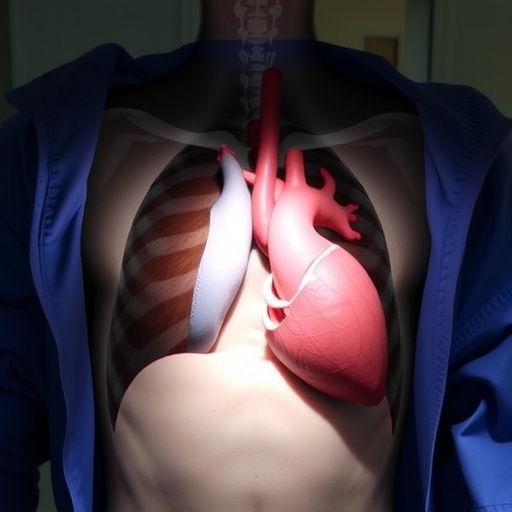In the ever-evolving landscape of mental health research, the intersection of eating disorders and psychosis presents a compelling yet complex challenge. Recent studies, including a case exploration by R. Elwyn, delve into the intricate relationships between these two conditions, offering insights that could lead to more tailored treatment methods. This research is particularly significant in a world where mental health issues are on the rise, necessitating informed interventions that can address the multifaceted nature of co-occurring disorders.
The emergence of co-occurring disorders, such as eating disorders coupled with psychosis, is a phenomenon that demands our immediate attention. Each condition can exacerbate the other, complicating diagnosis and treatment strategies. Eating disorders are often characterized by distorted body image and unhealthy eating patterns, while psychosis involves a disconnection from reality, including hallucinations and delusions. When these disorders coexist, the symptoms can overlap and intensify, creating a cycle that is challenging for both patients and healthcare providers to break.
Elwyn’s groundbreaking work emphasizes the importance of understanding the lived experiences of those affected by these dual diagnoses. By exploring personal narratives, Elwyn sheds light on the emotional turmoil faced by individuals dealing with both eating disorders and psychosis. These lived experiences provide a unique perspective that traditional clinical studies may overlook, highlighting the subjective reality of individuals grappling with these intertwined conditions.
The concept of personalized integrated treatment approaches is central to Elwyn’s findings. This methodology advocates for a holistic view of patients, recognizing that treatment should not only address the symptoms of the disorders but also take into account the wider context of an individual’s life. This approach can include psychotherapy, nutritional counseling, and psychotropic medication, tailored to meet the unique needs of each person. By personalizing treatment, clinicians can improve efficacy and enhance the overall well-being of their patients.
One of the notable challenges in treating co-occurring eating disorders and psychosis is the stigma surrounding both conditions. Individuals often face societal misconceptions that can lead to feelings of isolation and shame. This stigma can deter people from seeking help, exacerbating their conditions and prolonging their suffering. Elwyn’s work calls for greater awareness and education to combat these negative perceptions, fostering an environment where those affected feel safe to seek the support they need.
Evidence suggests that traditional treatment paradigms may not be sufficient when addressing co-occurring disorders. Often, standard practices focus singularly on one disorder at a time, leaving the other unaddressed. This can lead to incomplete recovery, where patients may show improvement in one area while their other condition worsens. Elwyn advocates for an integrated approach in which both disorders are treated concurrently, allowing for more comprehensive care that addresses the root causes and interconnections between the conditions.
In his exploration, Elwyn provides case examples that illustrate the diverse experiences of individuals facing these challenges. These narratives reveal common themes such as the struggle for identity, the quest for acceptance, and the fight against debilitating symptoms. By capturing these narratives, Elwyn demonstrates the need for empathy and understanding in the therapeutic process, urging clinicians to listen to their patients’ stories as integral parts of treatment planning.
Moreover, the study emphasizes the role of support systems in recovery. Family members, friends, and support groups can provide critical emotional backing and practical assistance. The involvement of loved ones in the treatment process can enhance the effectiveness of therapeutic interventions and create a network of care that promotes healing. Creating an atmosphere of support can empower individuals and motivate them to adhere to their treatment regimens.
Another significant concern raised by Elwyn is the impact of societal expectations on individuals with eating disorders and psychosis. The pressure to conform to unrealistic beauty standards often exacerbates feelings of inadequacy and contributes to the development of eating disorders. Additionally, the societal misunderstandings of psychosis can lead to fear and ostracism. These factors highlight the urgent need for social change, emphasizing the importance of promoting body positivity and mental health awareness in our communities.
Elwyn’s research also touches on the importance of early intervention. Identifying and addressing symptoms of both eating disorders and psychosis at an early stage can lead to better outcomes for individuals. This proactive approach can help mitigate the progression of symptoms, reducing the likelihood of severe episodes and improving overall quality of life. Health professionals are encouraged to remain vigilant for signs of these co-occurring disorders, ensuring that affected individuals receive timely and appropriate care.
Furthermore, advancements in technology and telehealth emerge as promising avenues for enhancing treatment accessibility. Virtual therapy sessions and online support groups can provide vital resources for those who may have difficulty accessing traditional in-person services. This flexibility can be particularly beneficial for individuals with mobility issues or those residing in remote areas, ensuring that help is available regardless of geographic limitations.
Elwyn’s exploration into co-occurring eating disorders and psychosis is not only a call to action for mental health professionals but also a beacon of hope for individuals dealing with these challenging conditions. As research continues to evolve, the goal remains clear: to bridge the gap between lived experiences and clinical practices. By prioritizing integrated treatment approaches, we can create a more compassionate and effective mental health care system that meets the diverse needs of individuals struggling with co-occurring disorders.
Ultimately, the journey toward recovery for individuals with eating disorders and psychosis is multifaceted and requires collaboration across disciplines. As society continues to grapple with mental health issues, it is imperative that we foster an environment of understanding, compassion, and comprehensive care. Elwyn’s groundbreaking research not only illuminates the paths individuals navigate but also provides a framework for developing innovative treatment modalities that can change lives for the better.
This exploration into the intricacies of co-occurring disorders serves as a vital reminder of the need for continued dialogue and action within the mental health field. By shining a light on the lived experiences of those suffering from eating disorders and psychosis, researchers and clinicians alike can work together to develop future strategies that prioritize patient-centered care and holistic recovery processes, ultimately transforming the landscape of mental health support.
Subject of Research: Co-occurring eating disorders and psychosis
Article Title: Co-occurring eating disorder and psychosis: a lived experience case exploration with examples and suggestions for personalized integrated treatment approach
Article References:
Elwyn, R. Co-occurring eating disorder and psychosis: a lived experience case exploration with examples and suggestions for personalized integrated treatment approach. J Eat Disord 13, 164 (2025). https://doi.org/10.1186/s40337-025-01270-6
Image Credits: AI Generated
DOI: 10.1186/s40337-025-01270-6
Keywords: Eating disorder, psychosis, integrated treatment, lived experience, mental health, early intervention.
Tags: challenges in diagnosing co-occurring disordersco-occurring eating disorders and psychosisemotional turmoil in eating disordershallucinations and eating disordershealthcare provider approaches to dual diagnosesimproving treatment strategies for psychosisintegrating treatment for eating disordersmental health research on dual diagnosespersonal narratives in mental healthrecent studies on eating disorders and psychosistailored interventions for complex disordersunderstanding psychosis and body image





